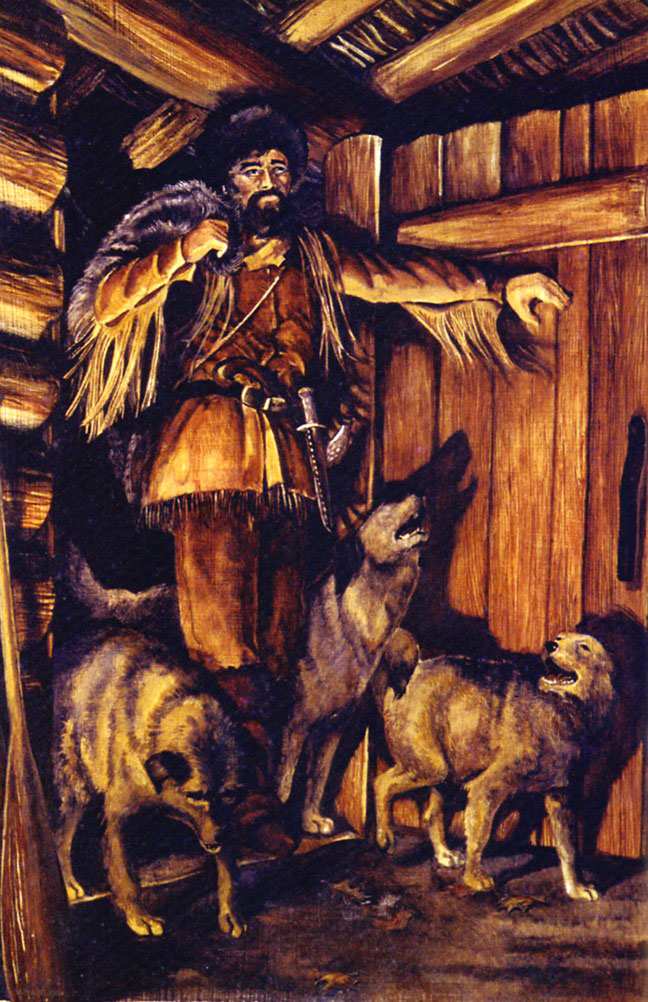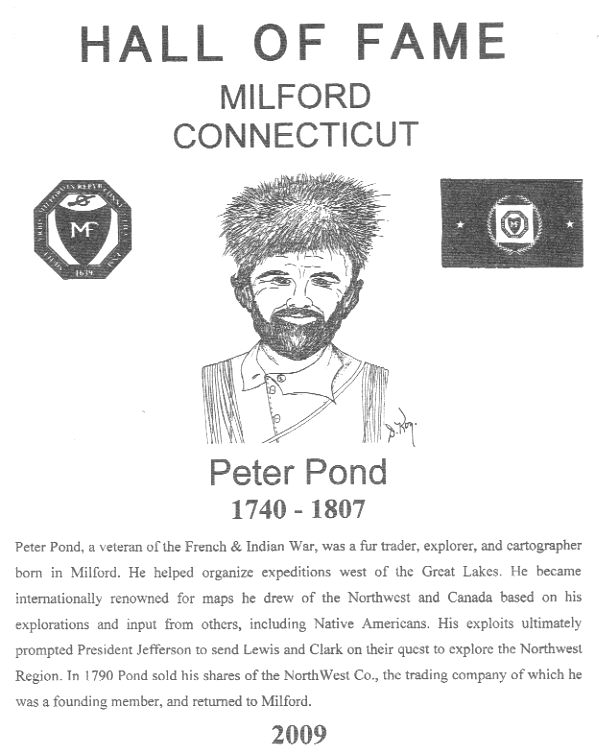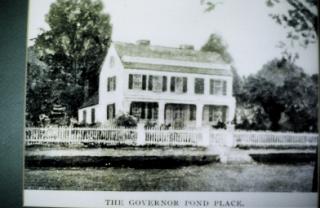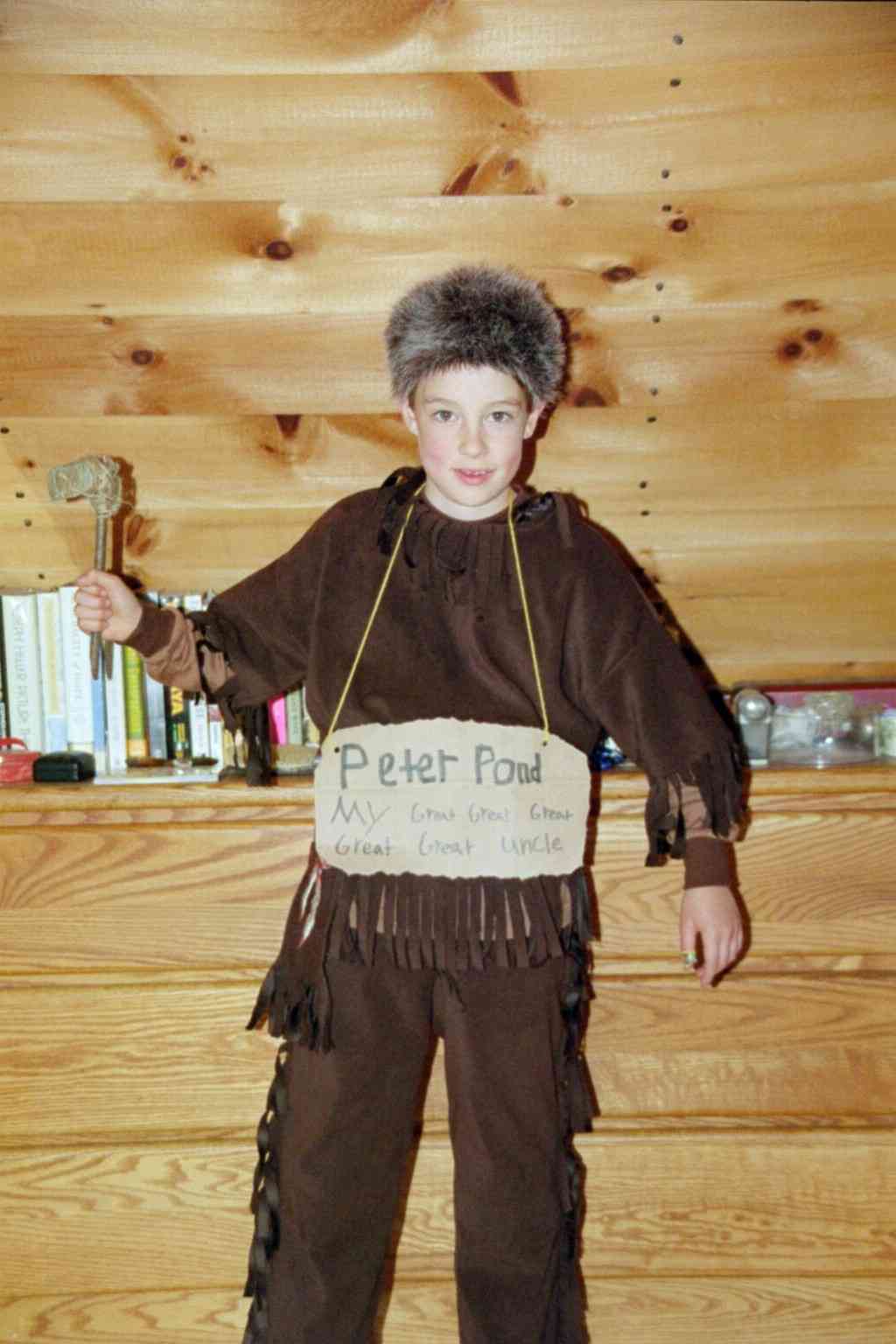Peter Pond newsletter :: April 2009 :: #35
HUGH MACMILLAN VISITS MILFORD
Author, historian and archivist Hugh MacMillan of Ottawa, Ontario visited Milford March 23-25 as the houseguest of Peter Pond Society charter member Susan D'Ambrosio. He was in town to pick up her bountiful fur trade library and papers she donated to his museum in Williamstown, Ontario. Since Hugh is legally blind, he was accompanied by his driver, Ron Gibbons, also of Ottawa. The nature of this trip was something Hugh had done for years criss-crossing Canada as a roving archivist (laison officer) locating and retrieving archival material for Ontario Archives 1964-1989. The more interesting experiences and discoveries are detailed in his book, Adventures of a Paper Sleuth, (Penumbra Press, 2004). That book along with other aspects of his life in his website. Hugh is pretty hale and hearty for 85.
I took Hugh and Ron for a Peter Pond tour Wednesday afternoon after Susan had me over for a fine dinner cooked by her husband, Bob, Tuesday night. The tour included stopping by the plaque showing the site of Gov. Charles Hobby Pond's house in which Peter Pond's diary was saved from becoming stove kindling in 1868 (see further down for house photo), driving around the mansion at the Academy of Mercy at Lauralton Hall, a private girls school, built by Charles Hobby Pond II in 1864 and originally named Island View, and the tour of Milford Cemetery. In the cemetery I showed them the Pond family plot which included the grave of Sophia Pond, the one who saved most of the diary from becoming stove kindling, Mary Pond, mother of Peter Pond and the adjacent site where a 2003 archeological dig took place in the unsuccessful effort to find Peter Pond's unmarked grave.
Hugh's history interest has concerned the fur trade as well. He went so far as to organize an epic voyage of three six-man 36-foot Montreal canoes to run from Grand Portage, Minn. to Williamstown in time to celebrate the opening of his Nor'Wester and Loyalist Museum on Sept. 2, 1967. This is where Susan has donated her collection. The trip also coincided with Canada's 100th anniversary, Expo 67, and pointed up early fur trade canoe routes and portages to commemorate the country's rich history from that era.
An interesting note is that Hugh had previously communicated with Susan's aunt, Vida Sharpe of Berkeley, Calif. who was doing her own fur trade research back in the 1970's. She bequeathed her fur trade library and correspondences with such notable fur trade historians as David Lavender and Walter O'Meara to Susan. Since no family members were interested in taking over the fur trade collection, Susan donated it to Hugh's museum. Susan thanked the Peter Pond Society for connecting her to Hugh. We had noted in an earlier newsletter she was descended from Roderick Mackenzie, Alexander's cousin. This was read by a present day Mackenzie in Canada who told Hugh about her. Susan, inviting me to dinner, noted that Hugh wanted to meet me and hear more about Peter Pond Society. I was pleased to meet this colorful Renaissance man and spend time with him. Turns out he is also a good friend of Barry Gough, retired college history professor who's book cover on Alexander Mackenzie graces my homepage. I also consider him my best Peter Pond information source. Small world.
MORE ON AUGUSTIN POND
I have devoted parts of several newsletters to the existence of a Peter Pond son, by a country wife, who became a blacksmith in the Athabasca area, as noted in Prof. Harry Duckworth's English River Book. The source of this information was mapmaker and explorer David Thompson, but it wasn't explained whether that was first or second hand information. I have found more apparent first-hand evidence of Augustin's activity in that area, thanks to DT authority Sean Peake, who helps his brother, Michael, put out that great quarterly newsletter on Canadian wilderness canoeing, Che-Mun. Sean sent me an attachment of 42 pages from DT's A Meteorological Journal at the Forks of the Peace River 1803-1804. DT wrote this journal while stationed there, in present day Alberta, to compete his Northwest Co. against Hudson's Bay Co. and XY Co., while also drawing many maps.
"Thompson doesn't identify him directly," Sean said, "but these passages could only mean one thing:
- July 9th. The rest of the Indians went away. Pond lighted his kiln of wood for charcoal. Bostona… with word that the hunter has killed a buck red deer in the Smoke River.
- July 21st Drying meat. The smith done with his kiln of charcoal.
- July 22nd Cardinal arranged a canoe at the other end of the portage. Smith at work."
- Pond is mentioned six more times with no blacksmith connection but just carrying our fur trade duties, such as:
- Feb. 16 Walked up the hills, finished the Manito Lake in courses. Pond and men with Maime to find a band of Indians. Three Iroquois from Mr. McGillivray. Wrote to Mr. Stuart. Indians drinking at XY expense."
I forwarded the material to David Chapin, working on a book about Peter Pond, and he was impressed:
"Hi Bill,
Thanks for sending that to me. It certainly sounds like Augustin Pond. Having a NWC blacksmith at the trading posts was very common, and they spent a lot of time fixing guns and other metal objects belonging to local people. I wonder if the "Bostona" mentioned was Bostonaise Pangman, the son of Peter Pangman.
I must admit that at this point I have been setting aside all the material about Pond's children for later, and I've yet to do any original research in that area. I'm most curious about who Augustin's mother was. My theory is that he was born in Michilimackinac, or thereabouts, but it is just speculation. It may be that the documents that Harry Duckworth found calling him "Arabaska," (or something like that) may be reference to him being an "Athabasca Man," meaning he was a voyageur who worked in the Athabasca district, but not someone who was born there. It seems like his retiring to the Michilimackinac area is a good indication that that was where he had family. That is all guess work though. I image Pond with a Great Lakes area girlfriend who he took along on his inland travels, but sadly the existence of the son seems to be the only evidence of a mother.
The book is coming along slowly, since the sources are all so fragmentary. My manuscript at this point reaches up to Pond's first crossing of the Methye Portage and the formation of the 1779 NWC agreement. A lot of it so far is concerned in working out the relationships between Pond and the whole collection of merchants and traders he worked with. Pretty soon I'm going to delve back into the CT side of the research to try to find out more about his post 1790 career. My working theory is that he invested in his other son's (Peter Pond Jr of Milford) seafaring career and went bankrupt due to his son's losses, but I just have some circumstantial evidence of that (mainly that Peter Pond Jr was a West Indies Sea captain who appears commanding his own vessel in 1790 and then went bankrupt in 1802).
So I was going to go up the Canoe conference at Hulbert again this spring, but I just had my check returned. I guess they are full up this year.
Regards,
Dave"
WHERE THE PETER POND DIARY WAS SAVED
Since I have put my entire Peter Pond slide show on a compact disc toward some day becoming a Powerpoint presentation, I have been able to lift any of it onto my hard drive. One is an artist's rendering of a house as you can see is called "The Governor Pond Place." The only Gov. Pond I ever heard of from Milford is Charles Hobby Pond (1781-1861) who served in that capacity 1852-1854 according to a plaque marking the site of the house which no longer exists. CHP would be Peter Pond's nephew since he was the son of Peter Pond's younger brother, Charles, better known around Milford since he fought in the American Revolution while Peter Pond was off trading and exploring in Canada. The small plaque, just to the left of steps leading up to the porch of a modest clapboard white building at 69 Broad Street, Milford, says in its entirety:
"Near this site stood the home of Charles
Hobby Pond, deputy governor and governor
of Connecticut 1852-1854"
"The ancient manuscripts were found by me in 1868, about to be destroyed with waste paper in the kitchen of the home of Hon. Charles Hobby Pond, governor of Connecticut."
Thought you would be interested.
CALEB DRESSED AS PETER POND
Here is another family member who has taken the time to commemorate Peter Pond. As you may remember, the last issue of the newsletter, in Peter Pond Society 34, David Eastman of Hartland, VT, describe his family's trip to Montreal in the spirit of PP to see the Fur Trade Museum at Lachine plus artifacts related to Peter Pond at the Queen Elizabeth Hotel's Beaver Club Restaurant. But the restaurant was unfortunately closed since employees were on strike. Caleb's grandmother, Betsey, is a Pond which, as the sign in the picture says, makes Peter Pond Caleb's great, great, great, great, great uncle. The newsletter came out in October but before Halloween when David said Caleb, 8, was going to wear his Peter Pond costume.
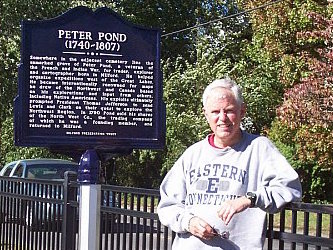
Au revoir,
Bill
website design by Daniel Ortoleva
